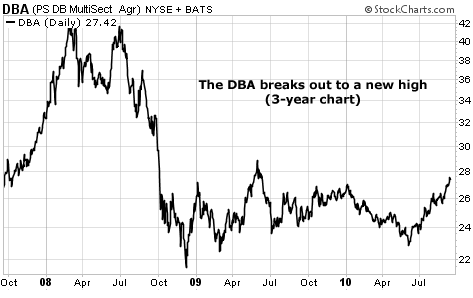| Home | About Us | Resources | Archive | Free Reports | Market Window |
The Single Best Income Strategy You Can Employ Right NowBy
Friday, September 17, 2010
Now that most conventional income investments have soared in price, I'm telling every income investor I know to switch to a much safer kind of investment.
I want them to switch to "bird in the bush" dividend opportunities.
"A bird in the hand is worth more than two in the bush," goes the common saying. But when it comes to income investing right now, this isn't true. Let me explain...
When you say "income investment," most people think of bonds, utilities, real estate investment trusts, and so on. These investments usually pay anywhere from 6% to 12% in income.
This is the "bird in the hand" dividend. You buy the stock. It pays you a big current dividend.
But there's another type of income investment most people never consider. These investments pay out much higher returns over the long pull.
The thing is, they don't have high current dividend yields. They may only yield 2% or 3%. But these income investments raise their dividends every year – relentlessly. Strong, stable companies that provide basic goods and services are where you find these relentless dividend growers... companies like Johnson & Johnson and Coca-Cola.
With relentless dividend growers, you don't immediately receive a dividend in the 6%-10% area. You start receiving a 2%-4% dividend, instead.
Then... an extraordinary thing happens...
Thanks to a dividend grower's excellent management and competitive position, its dividend gets bigger and bigger, pulling the stock price higher.
A great dividend grower will grow its payout at a 10% or 15% clip every year. Over the long term, a 10% dividend growth rate should generate 10% a year stock price growth. Here's how I explained it to my 12% Letter readers last month...
Let's say a stock pays a dividend of $1 per share, and its stock trades at $50. That's a 2% dividend yield. The next year, the dividend grows by 10% to $1.10 per share. Assuming the dividend yield remains at 2%, the company's stock price must also rise by 10% to $55 per share.
In other words, you get the 2% dividend. But more importantly, the 10% dividend growth translated into a 10% stock price gain, giving you a total return of 12%...
In the short term, this won't always be the case. But over the long term, studies have shown dividend growth and stock price growth have a strong correlation.
Holding relentless dividend-paying companies over the long term will eventually result in you earning 10%-20% dividends on your original purchase price.
This is my "bird in the bush" dividend. You don't get paid a big income this quarter, but over time, returns are spectacular.
Right now, I don't see too many attractive "bird in the hand" dividend opportunities. REITs, MLPs, and junk bonds have all soared. Yields are as low on these investments as I've ever seen them.
Given the risk in the economy, these low returns are not satisfactory anymore. (My readers have made huge profits from this trend, but we're close to cashing out.)
Meanwhile, I'm finding dozens of attractive "bird in the bush" income plays... and I'm encouraging my readers to focus on these opportunities right now, instead of conventional income ideas.
If you're interested in safely compounding your wealth and earning income along the way, I recommend you do the same.
Good investing,
Tom Dyson
Further Reading:
"Some folks are happy with a 2% dividend," Tom writes. "But that's probably because they don't know about a strategy that allows them to collect a 40% dividend... from the exact same stock." Learn how here: Turn an Ordinary Dividend Into a Double- or Triple-Digit Yield.
Last month, Tom showed DailyWealth readers a list of companies that have the potential to double your money every six years. "One day," Tom writes, "you'll open your brokerage statement to find... your wealth has mushroomed." Read more here: This Tiny Group of Stocks Beat the Market Every Year Since 1972.
Market NotesTHE AG COMPLEX IS HEATING UP After taking a dip early this year, the "ags" are finally moving again.
Back in mid-2009, we highlighted the series of "higher highs and higher lows" in the DBA, an investment fund that allows investors to own agricultural products like corn, soybeans, wheat, and sugar through the stock market.
We've taken an interest in the agricultural complex because outstanding investors like Jim Rogers and Marc Faber are long-term bullish on the idea... and it almost always pays to listen to these contrarian legends.
As you can see from today's chart, the DBA enjoyed that series of higher highs and higher lows for all of 2009, then weakened in 2010. But in the past few months, low inventories and bad growing weather have propelled this fund to its highest high in over a year. For folks who like to follow Rogers and Faber, this is fantastic price action... and bullish for our "farm income through the stock market" idea.
 |
In The Daily Crux
Recent Articles
|

